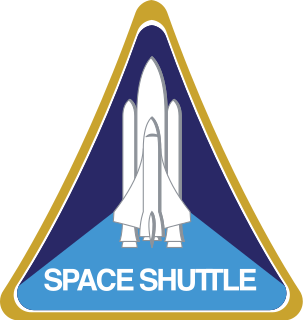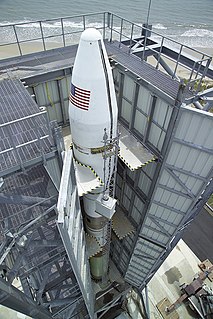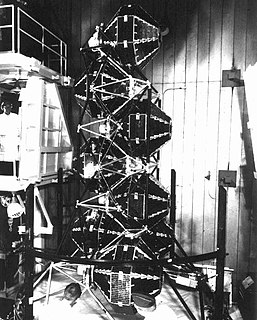
The Space Shuttle program was the fourth human spaceflight program carried out by the U.S. National Aeronautics and Space Administration (NASA), which accomplished routine transportation for Earth-to-orbit crew and cargo from 1981 to 2011. Its official name, Space Transportation System (STS), was taken from a 1969 plan for a system of reusable spacecraft of which it was the only item funded for development.
Human spaceflight programs have been conducted, started, or planned by multiple countries and companies. Until the 21st century, human spaceflight programs were sponsored exclusively by governments, through either the military or civilian space agencies. With the launch of the privately funded SpaceShipOne in 2004, a new category of human spaceflight programs – commercial human spaceflight – arrived. As of July 2021, three countries and one private company (SpaceX) have launched humans to Earth orbit, and two private companies have launched humans on a suborbital trajectory. The criteria for what constitutes human spaceflight vary. The Fédération Aéronautique Internationale defines spaceflight as any flight over 100 kilometers (62 mi). In the United States professional, military, and commercial astronauts who travel above an altitude of 80 kilometers (50 mi) are awarded the United States Astronaut Badge. This article follows the FAI definition of spaceflight.

A CubeSat is a type of miniaturized satellite for space research that is made up of multiple cubic modules of 10 cm × 10 cm × 10 cm size. CubeSats have a mass of no more than 1.33 kilograms (2.9 lb) per unit, and often use commercial off-the-shelf (COTS) components for their electronics and structure. CubeSats are put into orbit by deployers on the International Space Station, or launched as secondary payloads on a launch vehicle. As of August 2021, more than 1600 CubeSats have been launched and more than 90 have been destroyed in launch failures.

A small satellite, miniaturized satellite, or smallsat is a satellite of low mass and size, usually under 500 kg (1,100 lb). While all such satellites can be referred to as "small", different classifications are used to categorize them based on mass. Satellites can be built small to reduce the large economic cost of launch vehicles and the costs associated with construction. Miniature satellites, especially in large numbers, may be more useful than fewer, larger ones for some purposes – for example, gathering of scientific data and radio relay. Technical challenges in the construction of small satellites may include the lack of sufficient power storage or of room for a propulsion system.

The Minotaur is a family of United States solid fuel launch vehicles derived from converted Minuteman and Peacekeeper intercontinental ballistic missiles (ICBM). They are built by Northrop Grumman via contract with the Air Force Space and Missile Systems Center's Space Development and Test Directorate (SMC/SD) as part of the Air Force's Rocket Systems Launch Program which converts retired Intercontinental Ballistic Missiles into space and test launch systems for U.S. government agencies.

Time History of Events and Macroscale Interactions during Substorms (THEMIS) mission began in February 2007 as a constellation of five NASA satellites to study energy releases from Earth's magnetosphere known as substorms, magnetic phenomena that intensify auroras near Earth's poles. The name of the mission is an acronym alluding to the Titan Themis.

Artemis was a geostationary earth orbit satellite (GEOS) for telecommunications, built by Alenia Spazio for ESA. The Artemis satellite operated at the 21.5E orbital position until 2016, when it was moved to 123E to cover the L-Band spectrum rights for Indonesia's Ministry of Defense.

PicoSAT, launched on September 30, 2001, is a real time tracking satellite. The name "PICO" combines the first letters of all four of its experiments. PICOSat series are designed for a minimum of one year of on-orbit operations.

Launch Services Program (LSP) is responsible for NASA oversight of launch operations and countdown management, providing added quality and mission assurance in lieu of the requirement for the launch service provider to obtain a commercial launch license. It operates under the Human Exploration and Operations (HEO) Mission Directorate of NASA.

PSSC-2, or Pico-Satellite Solar Cell Testbed 2, also known as PSSC-Testbed 2, is a miniaturised satellite which was operated by the United States Air Force as part of a technology demonstration programme. It was the last satellite to be deployed from a Space Shuttle.

LauncherOne is a two-stage orbital launch vehicle developed and flown by Virgin Orbit that began operational flights in 2021, after being in development from 2007 to 2020. It is an air-launched rocket, designed to carry smallsat payloads of up to 300 kg (660 lb) into Sun-synchronous orbit (SSO), following air launch from a carrier aircraft at high altitude. The rocket is carried to the upper atmosphere on a modified Boeing 747-400, named Cosmic Girl, and released over the Pacific Ocean. Initial work on the program was done by Virgin Galactic, another Virgin Group subsidiary, before a separate entity— Virgin Orbit—was formed in 2017 to complete development and operate the launch service provider business as a separate entity from the passenger-carrying Virgin Galactic business.

Artemis 1, is a planned uncrewed test flight for NASA's Artemis program. It is the first flight of the agency's Space Launch System super heavy-lift launch vehicle and the first flight of the Orion MPCV. As of December 2021, Artemis 1 is expected to launch no earlier than March 2022, though the Inspector General expects it to slip to the summer of 2022.

Artemis 2, is the second scheduled mission of NASA's Artemis program, and the first scheduled crewed mission of NASA's Orion spacecraft, currently planned to be launched by the Space Launch System (SLS) in May 2024. The crewed Orion spacecraft will perform a lunar flyby test and return to Earth. This is planned to be the first crewed spacecraft to travel beyond low Earth orbit since Apollo 17 in 1972. Formerly known as Exploration Mission-2 (EM-2), the mission was renamed after the introduction of the Artemis program. Originally, the crewed mission was intended to collect samples from a captured asteroid in lunar orbit by the now canceled robotic Asteroid Redirect Mission.

Firefly Aerospace is an American private aerospace firm based in Austin, Texas, that develops launch vehicles for commercial launches to orbit. The company completed its $75 million Series A investment round in May 2021, which was led by DADA Holdings. The current company was formed when the assets of the former company Firefly Space Systems were acquired by EOS Launcher in March 2017, which was then renamed Firefly Aerospace.

Laser communication in space is the use of free-space optical communication in outer space. Communication may be fully in space or in a ground-to-satellite or satellite-to-ground application. The main advantage of using laser communications over radio waves is increased bandwidth, enabling the transfer of more data in less time.
ArgoMoon is a nanosatellite that will fly on NASA's Artemis 1 mission into a heliocentric orbit in cislunar space on the maiden flight of the Space Launch System (SLS) and the Orion spacecraft, in 2022. The satellite has the dimensions of a shoe box ; in CubeSat terms, it is a 6U.

Cislunar Autonomous Positioning System Technology Operations and Navigation Experiment (CAPSTONE) is a lunar orbiter that will test and verify the calculated orbital stability planned for the Gateway space station. The spacecraft is a 12-unit CubeSat that will also test a navigation system that will measure its position relative to NASA's Lunar Reconnaissance Orbiter (LRO) without relying on ground stations.

SAPPHIRE was a satellite built by the Stanford University students in Palo Alto, California.

Starshine 3 is one of five satellites in the Starshine project.

The Initial Defense Communications Satellite Program or IDCSP was the first United States Department of Defense communications satellite constellation and the first stage of the Defense Communications Satellite Program (DCSP). Launched in five groups by Titan IIIC launch vehicles to near equatorial, subsynchronous orbits between 1966 and 1968, they were intended to be experimental testbeds. They were so successful that, by the time of the launch of the last set of eight satellites, the IDCSP was deemed operational and renamed Initial Defense Satellite Communications System or IDSCS. This system allowed real-time collection of battlefield intelligence during the Vietnam War. A total of 35 IDCSP satellites were launched, 27 successfully.


















